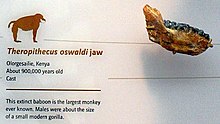Theropithecus oswaldi is an extinct species of Theropithecus from the early to middle Pleistocene of Kenya, Ethiopia, Tanzania, South Africa, Spain, Morocco and Algeria.[1] It appears to have been a specialised grazer.[2] The species went extinct in South Africa around 1.0 Ma.[3] Having existed alongside hominins like Homo erectus, it is likely that conflict with early humans played a role in their extinction as a site has been found with many juveniles butchered.[4] [5]
| Theropithecus oswaldi Temporal range: Pleistocene
| |
|---|---|

| |
| Fragmented jaw | |
| Scientific classification | |
| Domain: | Eukaryota |
| Kingdom: | Animalia |
| Phylum: | Chordata |
| Class: | Mammalia |
| Order: | Primates |
| Suborder: | Haplorhini |
| Infraorder: | Simiiformes |
| Family: | Cercopithecidae |
| Genus: | Theropithecus |
| Species: | †T. oswaldi
|
| Binomial name | |
| †Theropithecus oswaldi (Andrews, 1916)
| |
| Subspecies | |
| |
| Synonyms | |
| |
Description edit
It is remarkable for its large size compared to other old world monkeys. One source projects a specimen of Theropithecus oswaldi to have weighed 72 kg (159 lb).[6] Postcranial fossils found of this species are much greater in size than extant papionins, including the mandrill.[7]
References edit
- ^ "The Paleobiology Database". Retrieved 11 August 2013.
- ^ Van der Merwe, et al., 2003. The carbon isotope ecology and diet of Australopithecus africanus at Sterkfontein, South Africa. Journal of Human Evolution 44: 581-597.
- ^ Faith, J.T., 2014. Late Pleistocene and Holocene mammal extinctions on continental Africa. Earth-Science Reviews 128: 105-121
- ^ Shipman, Pat; Bosler, Wendy (June 1981). "Butchering of Giant Geladas at an Acheulian Site". Current Anthropology. 22: 257–288. doi:10.1086/202663. JSTOR 2742201. S2CID 87006937 – via JSTOR.
- ^ Getahun, D. A., Delson, E., & Seyoum, C. M. (2023). A review of Theropithecus oswaldi with the proposal of a new subspecies. Journal of human evolution, 180, 103373. https://doi.org/10.1016/j.jhevol.2023.103373
- ^ Jablonski, Nina; Leakey, Meave; Anton, Mauricio (1 January 2008), Jablonski, N.G. Leakey, M.G. and Anton, M. (2008) Systematic Paleontology of the Cercopithecines. In: Jablonski, N.G. and Leakey, M.G. (eds.) Koobi Fora Research Project. Volume 6. The Fossil Monkeys. California Academy of Sciences, San Francisco, pp. 103–300., pp. 103–300, retrieved 3 May 2020
- ^ Geraads, Denis; de Bonis, Louis (6 Feb 2020). "First record of Theropithecus (Cercopithecidae) from the Republic of Djibouti". Journal of Human Evolution. 138: 102686. doi:10.1016/j.jhevol.2019.102686. PMID 31759254. S2CID 208254366.